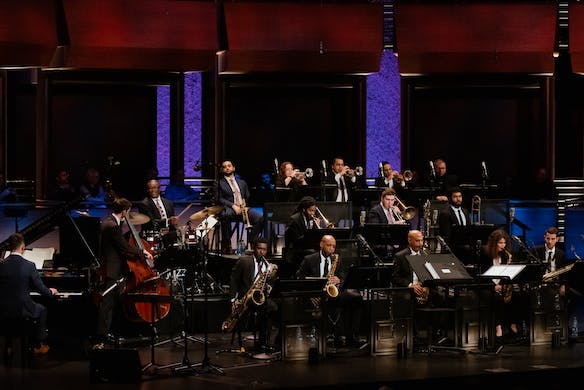Late Works From the Maestro, Duke Ellington, With an Eye on the Future
This amounted to a major experiment: Rather than the customary Jazz at Lincoln Center Orchestra, we were presented with a newly assembled orchestra of mostly 20-something musicians.

‘Internationally Ellington’
Jazz at Lincoln Center
This has been a very worldly season at Jazz at Lincoln Center, what with major events celebrating composers from the Middle and the Far East, Naseer Shamma of Iraq, in January, and Toshiko Akiyoshi of Japan, in March, and globally themed presentations of American icons, “Monk con Clave,” last May, and now “Internationally Ellington.”
It was an excellent idea for a concert: presenting works by Duke Ellington, mostly from his suites of the 1960s, that the maestro was inspired to compose during his extensive touring overseas in his final 15 years or so. The Jazz at Lincoln Center Orchestra has performed these before, especially the celebrated “Far East Suite.” What was surprising late last week was the ensemble selected to perform it.
This amounted to a major experiment for JALC: Rather than the customary Jazz at Lincoln Center Orchestra, we were presented with a newly assembled orchestra of mostly 20-something musicians, nearly all participants in JALC’s many educational outreach programs for student players. A great many were also graduates of Juilliard, such as conductor, musical director, and pianist Joe Block, and at least a few were current students there, such as the exceptional Israeli multi-reed player Daniel Cohen.
There were, however, three ringers in the ranks: the alto saxophone virtuoso Steve Wilson (62), who is a welcome presence in every bandstand or reed section lucky enough to get him; the remarkable, subtle, powerhouse drummer Herlin Riley; and longtime JALC Orchestra tenor saxophone star Walter Blanding (51). For years, I thought of Mr. Blanding as a new kid in the band, so it’s somewhat disconcerting to realize that he is one of the elder statesmen in the current context.
Mr. Blanding was the major soloist in the first number, “Mount Harrisa,” the dramatic opener of “The Far East Suite,” which brings up a fascinating issue in such jazz repertory projects. After being familiar with their work for so long, one tends to hear Mr. Blanding or Mr. Wilson differently than the newer, younger players when soloing.
The original tenor solo in “Mount Harrisa” was played by Paul Gonsalves; Mr. Blanding didn’t go out of his way to sound like Gonsalves — he sounded like himself. (To me, he always sounds a little like Sonny Rollins, and it’s hard to pay a higher compliment than that.)
Likewise, there were two performances of classic features for Johnny Hodges, the longtime Ellington alto superstar who had one of the most distinctive sounds of any saxophonist, and who was probably the band’s greatest master of both blues and ballads. When Zoe Abadia, a young saxophonist new to me, played the Hodges role on “Banquet Scene (Timon of Athens),” a piece that’s sort of a sequel to the more famous 1957 Shakespearian Suite (aka, “Such Sweet Thunder”), I could plainly hear Johnny Hodges. Yet, when Mr. Wilson played the key solo on “Isfahan,” Billy Strayhorn’s most famous contribution to “The Far East Suite,” I could only hear Steve Wilson.
Of the younger players, Mr. Cohen seemed to have a great solo on almost every number, both on clarinet, as on “Bluebird of Delhi” and on Ellington’s adaptation of “Anitra’s Dance” by Edvard Grieg, and on tenor, as on Duke’s resetting of the French song “Mademoiselle de Paris” and also on “A Flat Minor,” a blues from the 1956 “Thunder” sessions.
As good as the usual drummers with Wynton Marsalis and the Jazz at Lincoln Center Orchestra always are, we were all reminded this night that Herlin Riley is a cut above them all. During the first-act closer, “Amad,” Mr. Riley seemed to be effortlessly juggling all 16 other members of the orchestra in the air like so many tennis balls. If there is a better big band drummer playing today, I have never heard him.
The earliest piece played was “I Like the Sunrise” from the 1947 “Liberian Suite,” which might be considered the first of Ellington’s internationally themed long form works. It was sung by Robbie Lee, a very clean and precise vocalist with rather careful intonation, very much in contrast to the man who introduced it, Al Hibbler, a baritone given to extreme playful distortions that Ellington described as “tonal pantomime.” Sung reverently by Mr. Lee, it became clear that the spiritually driven “Sunrise,” which also featured a responding baritone sax solo by Josh Lee, is also a precursor to Ellington’s later sacred works.
The orchestra played multiple selections from “The Far East Suite” and “Such Sweet Thunder” (inspired by an English playwright, which makes it suitably international), but the major surprise and the unabashed highlight was a movement from “The Latin American Suite.” This is a 1970 Ellington work that, unlike some of the other suites, has virtually never been revived; it’s always been overshadowed by the better known earlier works and the sacred concerts.
Yet “The Sleeping Lady and The Giant Who Watches Over Her” is absolutely first-rate, top-drawer Duke; it began with a meditative piano solo, in which Mr. Block reconciled his own approach with the distinctive Ducal keyboard touch, and built to a crescendo that vividly depicted the folk tale it conveyed, the story of two lovers transformed into adjacent mountains. At this point, all of us in the house were wondering how we had missed this jewel of a piece all our lives.
Mr. Block quoted a famous Ellington line, “There are two kinds of music: good music and the other kind.” (Variations on which have been attributed to both Louis Armstrong and Irving Berlin, but no matter.) The program underscored the obvious conclusion that Duke Ellington himself created two kinds of music: well-known masterpieces and lesser-known masterpieces.

